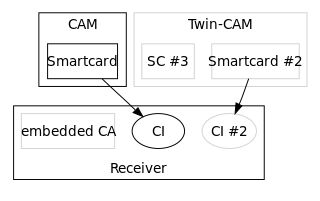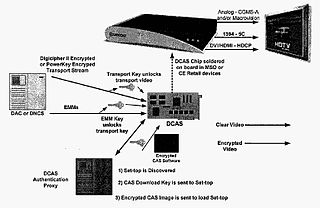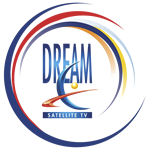| CA ID | Name | Developed by | Introduced (year) | Security | Notes |
|---|
| 0x4AEB | Abel Quintic | Abel DRM Systems | 2009 | Secure | |
| 0x4A64, 0x4AF0, 0x4AF2, 0x4B4B, 0x4B4C | ABV CAS | ABV International Pte. Ltd | 2006 | Secure (Farncombe Certified) | CA, DRM, Middleware & Turnkey Solution Provider For DTH, DVBT/T2, DVBC, OTT, IPTV, VOD, Catchup TV, Audience Measurement System, EAD etc. |
| 0x4AFC | Panaccess | Panaccess Systems GmbH | 2010 | Secure (Farncombe Certified) | CA for DVB-S/S2, DVB-T/T2, DVB-C, DVB-IP, OTT, VOD, Catchup etc. |
| 0x4B19 | RCAS or RIDSYS cas | RIDSYS, INDIA | 2012 | Secure | CA for DVB-C, IPTV, OTT, VOD, Catchup etc. |
| 0x4B30, 0x4B31 | ViCAS | Vietnam Multimedia Corporation (VTC) | Unknown | Secure (Farncombe Certified) | |
| 0x4800 | Accessgate | Telemann | Unknown | | |
| 0x4A20 | AlphaCrypt | AlphaCrypt | Unknown | | |
| N/A | B-CAS ARIB STD-B25 (Multi-2) | Association of Radio Industries and Businesses (ARIB) | 2000 | | CA for ISDB. Used in Japan only |
| 0x1702, 0x1722, 0x1762 | reserved for various non-BetaResearch CA systems | Formally owned by BetaTechnik/Beta Research (subsidiary of KirchMedia). Handed over to TV operators to handle with their CA systems. | Unknown | | |
| 0x1700 – 0x1701, 0x1703 – 0x1721, 0x1723 – 0x1761, 0x1763 – 0x17ff, 0x5601 – 0x5604 | VCAS DVB | Verimatrix Inc. | 2010 | | |
| 0x2600 0x2610 | BISS BISS-E | European Broadcasting Union | 2002 2018 | Compromised, BISS-E secure | |
| 0x27A0-0x27A4 | ICAS (Indian CAS) | ByDesign India Private Limited | 2015 | Advanced Embedded Secure | |
| 0x4900 | China Crypt | CrytoWorks (China) (Irdeto) | Unknown | | |
| 0x22F0 | Codicrypt | Scopus Network Technologies (now part of Harmonic) | Unknown | Secure | |
| 0x4AEA | Cryptoguard | Cryptoguard AB | 2008 | Secure | |
| 0x0B00 | Conax Contego | Conax AS | Unknown | Secure | |
| 0x0B00 | Conax CAS 5 | Conax AS | Unknown | Compromised | Pirate cards has existed |
| 0x0B00 | Conax CAS 7.5 | Conax AS | Unknown | Secure | |
| 0x0B00, 0x0B01, 0x0B02, 0x0BAA | Conax CAS 7 | Conax AS | Unknown | Compromised | Cardsharing |
| 0x0B01, 0x0B02, 0x0B03, 0x0B04, 0x0B05, 0x0B06, 0x0B07 | Conax CAS 3 | Conax AS | Unknown | Compromised | Pirate cards has existed |
| 0x4AE4 | CoreCrypt | CoreTrust(Korea) | 2000 | S/W & H/W Security | CA for IPTV, Satellite, Cable TV and Mobile TV |
| 0x4347 | CryptOn | CryptOn | Unknown | | |
| 0x0D00, 0x0D02, 0x0D03, 0x0D05, 0x0D07, 0x0D20 | Cryptoworks | Philips CryptoTec | Unknown | Partly compromised (older smartcards) | |
| 0x4ABF | CTI-CAS | Beijing Compunicate Technology Inc. | Unknown | | |
| 0x0700 | DigiCipher and DigiCipher II | Jerrold/GI/Motorola 4DTV | 1997 | Compromised | DVB-S2 compatible, used for retail BUD dish service and for commercial operations as source programming for cable operators. Despite the Programming Center shut down its consumer usage of DigiCipher 2 (as 4DTV) on August 24, 2016, it is still being used for cable headends across the United States, as well as on Shaw Direct in Canada. |
| 0x4A70 | DreamCrypt | Dream Multimedia | 2004 | | Proposed conditional access system used for Dreambox receivers. |
| 0x4A10 | EasyCas | Easycas | Unknown | | |
| 0x2719,0xEAD0 | InCrypt Cas | S-Curious Research & Technology Pvt. Ltd., Equality Consultancy Services | Unknown | | |
| 0x0464 | EuroDec | Eurodec | Unknown | | |
| 0x5448 | Gospell VisionCrypt | GOSPELL DIGITAL TECHNOLOGY CO., LTD. | Unknown | Secure | |
| 0x5501 | Griffin | Nucleus Systems, Ltd. | Unknown | | |
| 0x5581 | Bulcrypt | Bulcrypt | 2009 | | Used in Bulgaria and Serbia |
|
| 0x0606 | Irdeto 1 | Irdeto | 1995 | Compromised (Cardsharing and MOSC available) | |
| 0x0602, 0x0604, 0x0606, 0x0608, 0x0622, 0x0626, 0x0664, 0x0614 | Irdeto 2 | Irdeto | 2000 |
| 0x0624, 0x0648, 0x0650, 0x0639 | Irdeto 3 | Irdeto | 2010 | Compromised (Cardsharing available) | |
| 0x0692, 0x06A4, 0x06B6, 0x069F, 0x06AB, 0x06F1 | Irdeto Cloaked | Irdeto | Unknown | Secure | |
| 0x4AA1 | KeyFly | SIDSA | 2006 | Partly compromised (v. 1.0) | |
| 0x0100 | Seca Mediaguard 1 | SECA | 1995 | Compromised | |
| 0x0100 | Seca Mediaguard 2 (v1+) | SECA | 2002 | Partly compromised (MOSC available) | |
| 0x0100 | Seca Mediaguard 3 | SECA | 2008 | | |
| 0x1800, 0x1801, 0x1810, 0x1830 | Nagravision | Nagravision | 2003 | Compromised | |
| 0x1801 | Nagravision Carmageddon | Nagravision | Unknown | Combination of Nagravision with BetaCrypt |
| 0x1702, 0x1722, 0x1762, 0x1801 | Nagravision Aladin | Nagravision | Unknown | |
| 0x1801 | Nagravision 3 - Merlin | Nagravision | 2007 | Secure | |
| 0x1801 | Nagravision - ELK | Nagravision | Circa 2008 | IPTV |
| 0x4A02 | Tongfang | Tsinghua Tongfang Company | 2007 | Secure | |
| 0x4AD4 | OmniCrypt | Widevine Technologies | 2004 | | |
| 0x0E00 | PowerVu | Scientific Atlanta | 1998 | Compromised | Professional system widely used by cable operators for source programming |
| 0x0E00 | PowerVu+ | Scientific Atlanta | 2009 |
| 0x1000 | RAS (Remote Authorisation System) | Tandberg Television | Unknown | | Professional system, not intended for consumers. |
| 0x4AC1 | Latens Systems | Latens | 2002 | | |
|
| 0xA101 | RosCrypt-M | NIIR | 2006 | | |
| 0x4A60, 0x4A61, 0x4A63 | SkyCrypt/Neotioncrypt/Neotion SHL | AtSky/Neotion [3] | 2003 | | |
| Unknown | T-crypt | Tecsys | Unknown | | |
| 0x4A80 | ThalesCrypt | Thales Broadcast & Multimedia [4] | Unknown | | Viaccess modification. Was developed after TPS-Crypt was compromised. [5] |
| 0x0500 | TPS-Crypt | France Telecom | Unknown | Compromised | Viaccess modification used with Viaccess 2.3 |
| 0x0500 | Viaccess PC2.3, or Viaccess 1 | France Telecom | 1996 | |
| 0x0500 | Viaccess PC2.4, or Viaccess 2 | France Telecom | 2002 | |
| 0x0500 | Viaccess PC2.5, or Viaccess 2 | France Telecom | 2003 | |
| 0x0500 | Viaccess PC2.6, or Viaccess 3 | France Telecom | 2005 | |
| 0x0500 | Viaccess PC3.0 | France Telecom | 2007 | |
| 0x0500 | Viaccess PC4.0 | France Telecom | 2008 | |
| Unknown | Viaccess PC5.0 | France Telecom | 2011 | Secure | |
| Unknown | Viaccess PC6.0 | France Telecom | 2015 | |
| 0x0930, 0x0942 | Synamedia VideoGuard 1 | NDS (now part of Synamedia) | 1994 | Partly compromised (older smartcards) | |
| 0x0911, 0x0960 | Synamedia VideoGuard 2 | NDS (now part of Synamedia) | 1999 | Secure | |
| 0x0919, 0x0961, 0x09AC, 0x09C4, 0x091F, 0x0944, 0x09AA | Synamedia VideoGuard 3 | NDS (now part of Synamedia) | 2004 | Secure |
| 0x0927, 0x09BF, 0x0910, 0x0913, 0x098C, 0x098D, 0x098E, 0x0911, 0x0950, 0x09BB, 0x0987, 0x0963, 0x093B, 0x09CD | Synamedia VideoGuard 4 | NDS (now part of Synamedia) | 2009 | Secure |
|
| 0x56D0 | Onnet CA/DRM | Onnet Systems India Pvt. Ltd. | 2021 | Secure | CA/DRM, IPTV Middleware, OTT, Interactive Services, STB Middleware, AR/VR |
| 0x4AD0, 0x4AD1 | X-Crypt | XCrypt Inc. | 2010 | Secure | |
| 0x4AE0, 0x4AE1, 0x7be1 | DRE-Crypt | Cifra | 2004 | Secure | |
| Unknown | PHI CAS | RSCRYPTO | 2016 | Secure | |










